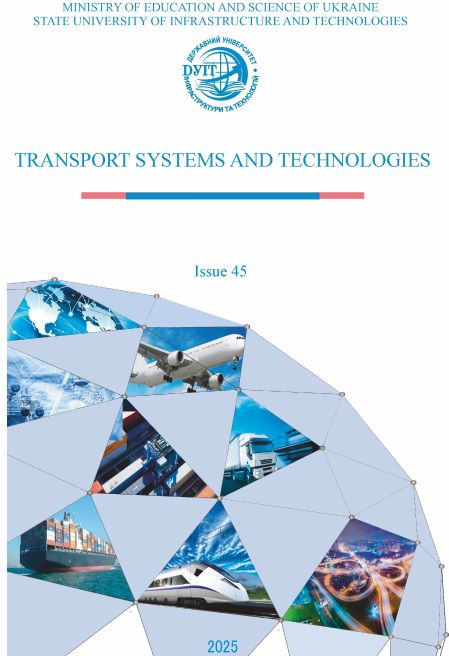Study of stress-strain state of passenger car body
Keywords:
railway transport, passenger car, body, reliability, load, wear, stresses, optimizationAbstract
The article presents the stress-strain state analysis results of the load-bearing elements of the body and frame of the 61-779 model passenger car. To assess the strength of the car body, the finite element method was used with the ANSYS software package. In the model, the body is represented as a system consisting of beam, shell, and solid finite elements. The connections are modeled using rigid links. The model contains a total of 890,436 nodes and 321,874 finite elements. Boundary conditions include restrictions of freedom in support nodes (fixed support) and applied external loads. The main load-bearing element of the car structure is the center sill, made of I-beam profile No. 30. Additional fastening elements are used to increase the stiffness of the connections between the center sill and the crossbeams. The sheathing is made of structural and stainless sheet steel. Corrugated metal 2 mm thick is used as the outer sheathing. A study was conducted on the stress-strain state of the car body with nominal dimensions. The highest stress under load occurs in the bolster beam at the point of contact with the end beam of the frame and amounts to 258 MPa. The stress in the body sheathing between window openings is 65 MPa. The results obtained will further determine the direction of research on the optimization of load-bearing structures of the frame and body.
References
Bozhok, N. O., Bulgakova, Y. V., & Pularia, A. L. (2014). Research on the current state of the passenger car fleet. Review of transport economics and management, (8), 78-87. in Ukrainian.
Loboyko, L. N., & Barash, Yu. WITH. (2007). State of the wagon park and wagon repair base in Ukraine. Science and progress of transport. Bulletin of the Dnipropetrovsk National University of Railway Transport, (19), 176-182. in Ukrainian.
Kirpa, G. M. (2004). Integration of Ukrainian railway transport into the European transport system. D.: Publishing house of Dnipropetrovsk National University of Railway Transport named after Acad. V. Lazaryan. [in Ukrainian].
Martynov, I., Trufanova, A., Petukhov, V., & Serhiienko, M. (2021). Research of the dependence of operation of carrying elements of passenger cars. Transport Systems and Technologies, (36), 72–81. in Ukrainian. https://doi.org/10.32703/2617-9040-2020-36-8.
Martynov, I. E., Trufanova, A. V., Pavlenko, Yu. S., & Sergienko, M. O. (2018). Analysis of the technical condition of passenger car bodies. Bulletin of the National Technical University of KhPI. Series: New solutions in modern technologies, (45), 41-46. https://doi.org/10.20998/2413-4295.2018.45.06. in Ukrainian.
Myamlin, S. V., Yagoda, P. A., Dedaeva, T. A., & Shkabrov, O. A. (2006). Reducing the weight of metal structures of passenger cars for high-speed transportation. Bulletin of the Dnipropetrovsk National University of Health Transport named after Academician V. Lazaryan, (13), 118-120. in Ukrainian.
Prikhodko, V. I., Shkabrov, O. A., Myamlin, S. V., & Yagoda, P. A. (2007). Improving the design of passenger car bodies for high-speed transportation. Bulletin of the Dnipropetrovsk National University of Health Transport named after Academician V. Lazaryan, (14), 152-156. [in Ukrainian].
Prikhodko, V. I. (2006). Calculation of dynamic indicators of a passenger car. Science and progress of transport. Bulletin of the Dnipropetrovsk National University of Health Transport named after Academician V. Lazaryan, (12), 146-152. [in Ukrainian].
Sun, W., Zhou, J., Gong, D., & You, T. (2016). Analysis of modal frequency optimization of railway vehicle car body. Advances in Mechanical Engineering, 8(4), 1687814016643640. https://doi.org/10.1177/1687814016643640.
Sharma, S. K., Sharma, R. C., & Lee, J. (2022). In situ and experimental analysis of longitudinal load on carbody fatigue life using nonlinear damage accumulation. International Journal of Damage Mechanics, 31(4), 605-622. https://doi.org/10.1177/10567895211046043/.
Song, Y., Wu, P., & Jia, L. (2016). Study of the fatigue testing of a car body underframe for a high-speed train. Proceedings of the Institution of Mechanical Engineers, Part F: Journal of Rail and Rapid Transit, 230(6), 1614-1625. https://doi.org/10.1177/0954409715618425.
de Cisneros Fonfría, J. J. J., Olmeda, E., Sanz, S., Garrosa, M., & Díaz, V. (2024). Failure analysis of a train coach underframe. Engineering Failure Analysis, 156, 107756. https://doi.org/10.1016/j.engfailanal.2023.107756.
Bingrong Miao, & Dingchang Jin. (2009). Evaluation of Railway Vehicle Car Body Fatigue Life and Durability using a Multi-disciplinary Analysis Method. International Journal of Vehicle Structures and Systems, 1(4). https://doi.org/10.4273/ijvss.1.4.05.
Martynov, I., Kalabukhin, Y., Trufanova, A., & Martynov, S. (2024). Analysis of stress state of passenger car bodies. Transport systems and technologies, (43), 111-120. in Ukrainian. https://doi.org/10.32703/2617-9059-2024-43-9.
Cascino, A., Meli, E., & Rindi, A. (2023). Dynamic size optimization approach to support railway carbody lightweight design process. Proceedings of the Institution of Mechanical Engineers, Part F: Journal of Rail and Rapid Transit, 237(7), 871-881. https://doi.org/10.1177/09544097221140933.
Kobishanov, V.V., Lozbinev, V.P., Sakalo, V.I., Antipin, D.Y., Shorohov, S.G., & Vysocky, A.M. (2013). Passenger Car Safety Prediction. World Applied Sciences Journal, 24, 208–212. https://www.idosi.org/wasj/wasj24(1)/ 2013.htm.
Baykasoglu, C., Sunbuloglu, E., Bozdag, S. E., Aruk, F., Toprak, T., & Mugan, A. (2012, April). Numerical static and dynamic stress analysis on railway passenger and freight car models. In International Iron & Steel Symposium (pp. 02-04)..
Baykasoğlu, C., Sünbüloğlu, E., Bozdağ, S. E., Aruk, F., Toprak, T., & Mugan, A. (2011). Railroad passenger car collision analysis and modifications for improved crashworthiness. International Journal of Crashworthiness, 16(3), 319-329.https://doi.org/10.1080/13588265.2011.566475.
DSTU 7774:2015. (2017). Mainline passenger locomotive-drawn wagons. General technical standards for the calculation and design of mechanical parts of wagons. Ministry of Economic Development of Ukraine. in Ukrainian.
Martynov, I. E., Trufanova, A. V., Shovkun, V. O., Martynov, S. I., & Ostapenko, Ya. V. (2023). Modeling the stress-strain state of a rigid-compartment passenger car body. Collection of scientific papers "Rail rolling stock", (27), 59-69. https://doi.org/10.47675/2304-6309-2023-27-59-69.
Downloads
Published
How to Cite
Issue
Section
License

This work is licensed under a Creative Commons Attribution 4.0 International License.
Copyright: This is an open-access article distributed under the terms of the Creative Commons Attribution License, which permits unrestricted use, distribution, and reproduction in any medium, provided the original author and source are credited.














